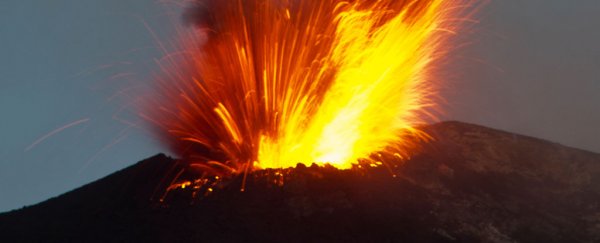Scientists in the US have discovered that rare volcanic eruptions – so catastrophically powerful that they could potentially devastate the entire planet – might only give up to a year's warning before they unleash fiery hell.
Super-eruptions, which can eject thousands of cubic kilometres of magma to the planet's surface, build up over a massive time frame – but volcanic samples suggest the final stage of decompression before magma release happens much more quickly.
"The evolution of a giant, super-eruption-feeding magma body is characterised by events taking place at a variety of time scales," says geochemist Guilherme Gualda from Vanderbilt University.
"Now we have shown that the onset of the process of decompression, which releases the gas bubbles that power the eruption, starts less than a year before eruption."
To investigate the duration of the final stage before a super-eruption, Gualda and fellow researcher Stephen Sutton from the University of Chicago examined quartz crystal deposits from Bishop Tuff – a rocky outcrop that formed from the super-eruption that created the Long Valley Caldera in central California some 760,000 years ago.
Scientists previously thought that this quartz crystal – which covers the surface rims at super-eruption sites – formed over the course of several decades in the period immediately prior to an eruption, but the new research indicates the time scale could be much shorter.
Using a new method to measure rim growth times based on the concentration of titanium in the crystal, the scientists think that the eleventh hour before a super-eruption can occur very quickly, capping a volcanic buildup that might have slowly developed over tens of thousands of years.
"Maximum rim growth times span from approximately 1 minute to 35 years, with a median of approximately 4 days," the researchers write in PLOS ONE. "More than 70 percent of rim growth times are less than 1 year, showing that quartz rims have mostly grown in the days to months prior to eruption."
According to the researchers, this rim growth heralds the onset of a transition from "pre-eruptive to syn-eruptive conditions", during which volcanic magma would begin to decompress and expand underground – a geological phenomenon that the researchers suggest would likely have noticeable effects on the Earth's surface in the final months before a cataclysmic super-eruption.
Why would a super-eruption be so dangerous? Not necessarily because of the ejection of magma and massive geological movements on a local scale – meaning you really wouldn't want to be close-by for this one – but because of the huge dispersal of ash clouds in the atmosphere, which could block out the light and heat of Sun, potentially for years or even decades.
The 1815 Eruption of Mount Tambora is the largest super-eruption in recent (recorded) history, and the subsequent ash cloud lowered temperatures around the globe – creating in 1816 what became known as the "Year Without a Summer", the "Poverty Year", the "Summer that Never Was", and any number of other dramatic nicknames.
The good news is that the researchers think that Earth's supervolcanos that could give rise to subsequent super-eruptions in the future – like Yellowstone Caldera in the US and Lake Toba in Indonesia – won't do so any time soon – although we're finding out more all the time about the state of these sites.
In any case, it's likely that the world hasn't seen its last year without a summer – but hopefully it won't be something that happens in the near future.
"As far as we can determine, none of these places currently house the type of melt-rich, giant magma body needed to produce a super-eruption," said Gualda.
"However, they are places where super-eruptions have happened in the past so are more likely to happen in the future."
